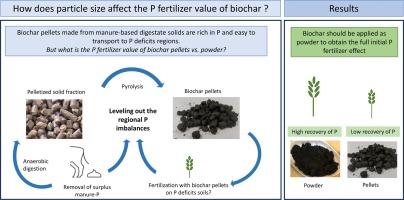Particle size determines the short-term phosphorus availability in biochar produced from digestate solids
IF 7.1
2区 环境科学与生态学
Q1 ENGINEERING, ENVIRONMENTAL
引用次数: 0
Abstract
Biochar pellets produced from the solid fraction of manure-based digestates are rich in phosphorus (P) and may represent a P source that is easy to handle and suitable for transport to P-deficient regions. However, the effect of feedstock composition and particle size on P availability in this type of biochar remains unexplored.
To evaluate the effect of particle size on the short-term P availability in biochars derived from manure digestate solids, an incubation experiment was carried out, in which four biochars produced from digestate solids in powder and pellet form were incubated with three soils of low P content. The recovery of P in bicarbonate and water extracts was measured after 7 and 70 days of incubation. A subsequent pot experiment with barley on two of the soils was aimed at examining early crop recovery of P, comparing the effects of coarse and fine biochar particles.
Biochars from digestate solids had total P contents ranging from 12 to 63 g kg−1. In all three soils, the recovery of P in water and bicarbonate extracts was lower after incubation with biochar pellets compared to powder, and P recovery remained constant or decreased slightly over time. Early shoot biomass and P recovery in barley were also higher when fine biochar particles were applied. The results suggest that particle size reduction improves the immediate availability of P in biochars produced from manure-based digestate solids.

粒度决定了用沼渣固体生产的生物炭中磷的短期可用性。
由粪便沼渣固体部分生产的生物炭颗粒富含磷 (P),可能是一种易于处理且适合运往缺磷地区的磷源。然而,原料成分和颗粒大小对这类生物炭中磷的可用性的影响仍有待探索。为了评估颗粒大小对粪便沼渣固体制备的生物炭中钾的短期可用性的影响,我们进行了一项培养实验,将沼渣固体制备的四种粉末状和颗粒状生物炭与三种钾含量较低的土壤进行培养。培养 7 天和 70 天后,测量了碳酸氢盐和水提取物中 P 的回收率。随后在其中两种土壤上用大麦进行了盆栽实验,目的是考察作物早期的钾回收情况,并比较粗粒和细粒生物炭的效果。来自沼渣固体的生物炭的总磷含量为 12 至 63 克/千克。在所有三种土壤中,与粉末相比,使用生物炭颗粒培养后,水和碳酸氢盐提取物中 P 的回收率较低,而且随着时间的推移,P 的回收率保持不变或略有下降。施用细生物炭颗粒时,大麦的早期芽生物量和钾回收率也更高。结果表明,粒度的减小提高了以粪便为基础的沼渣固体生产的生物炭中 P 的即时可用性。
本文章由计算机程序翻译,如有差异,请以英文原文为准。
求助全文
约1分钟内获得全文
求助全文
来源期刊

Waste management
环境科学-工程:环境
CiteScore
15.60
自引率
6.20%
发文量
492
审稿时长
39 days
期刊介绍:
Waste Management is devoted to the presentation and discussion of information on solid wastes,it covers the entire lifecycle of solid. wastes.
Scope:
Addresses solid wastes in both industrialized and economically developing countries
Covers various types of solid wastes, including:
Municipal (e.g., residential, institutional, commercial, light industrial)
Agricultural
Special (e.g., C and D, healthcare, household hazardous wastes, sewage sludge)
 求助内容:
求助内容: 应助结果提醒方式:
应助结果提醒方式:


